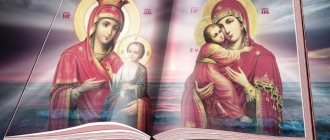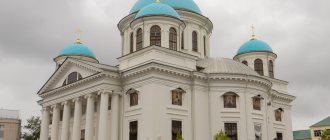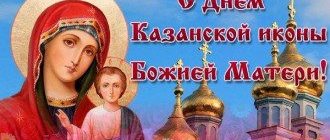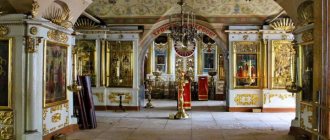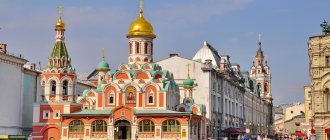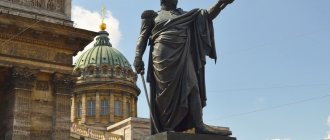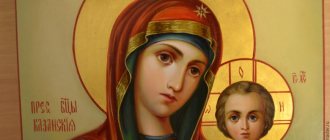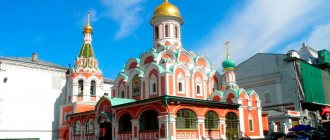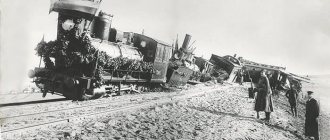Where is the authentic image of the Kazan Mother of God actually located?
From the editor: The Kazan Icon of the Blessed Virgin Mary is especially revered in Russia. This image is in every Orthodox family and in every church. There are many known miraculous copies of the Kazan Icon. The image itself, revealed in Kazan in 1579, was stolen in 1904 and is still considered lost. In her article, journalist and film director Emilia Aronova convincingly says that the revealed image always remained in Kazan.
Currently, the icon is in the Yaroslavl Wonderworkers Church at the Arskoe cemetery.
Mysterious old lady
Several years ago, during a patronal feast day in an Old Believer church in Kazan, after a service, procession and festive meal, a modest old woman approached one of the visiting foreign bishops. She held out a postcard on which the Kazan Icon of the Mother of God was depicted, and joyfully said:
—Have you never been to Kazan before and seen the real revealed Kazan Icon? Let's go! I know where she is now! I'll show it to you!
Either Vladyka did not understand well, or he was in a hurry to attend to other matters, but he smiled politely and walked past. The old woman moved sadly along the fence near the temple and placed a postcard with the image on the chipped bricks. People quickly dispersed. The wonderful face on the small postcard smiled faintly.
Rome, Florence, St. Petersburg
Paul I wanted the new building to resemble St. Peter's Basilica in Rome. Andrey Voronikhin designed a grandiose colonnade, which echoed the design of the Italian temple. The 96 columns of the Kazan Cathedral were not located along the perimeter; they swung open towards Nevsky Prospekt. The northern side of the temple became the front side. According to Voronikhin’s plan, a colonnade should have been erected on the southern side of the temple, but this idea was later abandoned.
The northern gates of the cathedral were cast in bronze after the model of the “Heavenly Doors” of the Florentine Baptistery - the original was created in the 15th century by the sculptor Lorenzo Ghiberti. Contemporaries criticized Voronikhin for architectural borrowings and even called him a “copyist.”
Church of the Nativity of the Blessed Virgin Mary (Kazan Church) (1733-1737 - M.G. Zemtsov). Photo: hellopiter.ru
Roman Cathedral of St. Peter (1547-1564 - Michelangelo Buonarroti, from 1607 - C. Maderna, 1656-1667 - L. Bernini). Plan. Photo: rhplan.ru
The facade of the Kazan Cathedral from Nevsky Prospekt (1801-1811 - A.H. Voronikhin). Plan. Photo: townevolution.ru
A great variety of lists
If you ask in the capital of Tatarstan where the famous Kazan icon is, each person will answer differently: in that place, or in that. If you sequentially walk through all the indicated temples of Kazan, then indeed, in each you can find your own miraculous face of the Mother of God. All the icons are of ancient writing, are in rich icon cases, touching and beautiful in appearance. People turn to the Kazan icons of the Mother of God more often than to others. And the Queen of Heaven helps everyone. Each icon has gold rings and objects hanging - evidence of grateful people that their prayers are heard by God.
The Kazan Icon of the Mother of God is the most popular in Russia. Before the revolution, Kazan was known to Christians all over the world. People of all Christian denominations and accords came here to see the Shrine and pray to Her. Pilgrims brought up to 70% of the city's income. Currently, the flow of tourists to the Kazan Icon is increasing every year. A pilgrimage center has been created at the revived Kazan Mother of God Monastery. But few people are looking for the revealed image. Everyone goes to the Vatican list.
What is the value of the original icon, why did our ancestors so reverently honor and take care of it?
Loss of the revealed icon
On the night of June 28-29, 1904, the thief Stoyan Chaikin penetrated the walls of the Kazan Mother of God Monastery, tied up the guard, broke open the doors of the main church and took away two icons - the Savior Not Made by Hands and the Kazan Image of the Mother of God.
The order of the prosecutor of the Kazan district court to the head of the gendarme department read: “...at about 2 o’clock in the morning the theft of two icons was committed in Kazan, in the summer church at the Mother of God convent: the miraculous Kazan Mother of God and the Savior. Both of these icons were in precious vestments, valued: on the icon of the Mother of God up to 70 thousand rubles and on the icon of the Savior up to 30 thousand rubles. In addition, about 600 rubles were stolen from two candle boxes by breaking into them...”
Detectives caught the thief in hot pursuit. When asked where the icons were, he replied that their frames were sold, and the images themselves were chopped with an ax and burned in an oven.
Schedule of services of the Kazan Cathedral on Red Square
Those wishing to receive the Sacrament of Baptism can contact the ministers for a public conversation every Saturday at 15:00.
Religious events take place daily in the temple:
- 08:00 (weekdays) 08:30 (Sat) and 09:00 (Sun) - liturgy,
- 14:00 (Sat) - Unction
- 17:00 - evening services (parastas, all-night vigil).
On the website of the Kazan Cathedral you can see a detailed schedule of events for the current month, as well as find out the names of the clergy who will conduct the rituals and their assistants.
© Official website of the Moscow Patriarchate
Schedule of services 2022 on the official website of the Cathedral of the Kazan Icon of the Mother of God
"Vatican" icon
Many people doubted that the miraculous face was destroyed. Most likely, the thief Chaikin sold it. After all, he could not help but understand that the image itself was worth much more than any salary. Almost a century after the theft of the Kazan Icon, the image, which many people considered to be the same revealed face stolen in 1904, returned to Russia. The Kazan Icon of the Mother of God became the property of the entire Orthodox world, having traveled around the world.
In the first years of Soviet power, many valuable objects of art and antiquities were exported from Russia abroad; in this flow, the so-called Vatican copy of the Kazan Icon of the Mother of God was sent to the West. In one of the materials of the Kazan diocesan administration, the “path of the icon home” was described in detail:
“In 1928 , Norman Weiss bought the old list. The list ends up in England and soon finds a new “owner,” millionaire Frederick Mitchell-Hedges.
In 1953 , a collector bought Farley Castle in the English province of Berkshire. The image of the Virgin Mary he acquired was open to believers, began to show miracles and became widely known among emigrants under the name “Black Virgin Mary of Farleigh Castle.”
Orthodox believers, mainly Russians from the first wave of emigration, began to come to the icon. Some emigrants convinced the owner that this icon was kept in the Kazan Cathedral in Moscow, others claimed that they saw it in the capital of the Russian Empire, St. Petersburg! Meanwhile, we know that the Moscow and St. Petersburg lists are very different from each other.”
The expert in 1954 was Nikolai Efremovich Andreev , a historian, literary and art critic, professor at the University of Cambridge. A comparative analysis of three Kazan Mother of God icons kept in Kazan, Moscow and St. Petersburg was carried out, and the conclusion was made: “The image of the Kazan Icon of the Mother of God, which appeared in England, largely coincides with the surviving descriptions of the icon that disappeared from Kazan, but its dimensions are different : 7 inches long and 6 wide (i.e. 31 x 27 cm). The face of the Mother of God is beautiful, dark and undoubtedly the work of a master. It was painted in the Italo-Cretan manner... The figures of the Mother of God and the Child fully correspond to the inventory of the stolen icon, as well as the position of the blessing right hand... If this is not the Kazan revealed icon, then it is undoubtedly an excellent copy with amazing power in the faces and in colors, still undescribed and almost contemporaneous with the Kazan icon, and is a well-dated monument, closely connected with the events of the history of Muscovite Rus'.”
The Kazan icon, as we know, became especially famous at the end of the Time of Troubles. When in 1611 the people's militia set out to liberate Moscow from the Poles, there was a prototype of the icon. It is in memory of these events that the holiday of November 4 was established in honor of the Kazan Icon of the Mother of God. After the victory, the Kazan Cathedral on Red Square was rebuilt for the Heavenly Protectress. It contained a copy of the image of the Mother of God revealed in Kazan. The Russians have forever fallen in love with this miraculous face.
But this icon also turned out to be stolen in the new Soviet times directly from the altar of the Moscow Kazan Cathedral. This time no one found either the kidnappers or witnesses to the crime. It turns out that the icon that appeared in England could have been both a Kazan and a Moscow image. Or various robbers sold several miraculous icons abroad.
It is difficult to understand where the revealed image was kept - in Kazan, Moscow or St. Petersburg. It is even more difficult to figure out what kind of image arrived in San Francisco in 1962 for research and sale. The conclusion of the members of the International Institute for the Protection, Verification and Restoration of Paintings is of interest: “The icon is painted on a linden board, strongly warped by age, measuring 105/8 x 1274 inches. ...the icon could not have been painted later than 1450 according to the English calendar. The icon has been the subject of numerous tests in England, including X-ray tests, which show that it is genuine."
The Kazan Icon, purchased by Catholics, was transferred to the Church of St. Fatima on July 21, 1970, on the feast of the acquisition of the image of the Virgin Matrona. The miraculous image was taken to Lisbon on March 1, 1993, and then the icon was transported to the Vatican, where it took the place long ago prepared for it, firmly settling in the very heart of the Holy See - in the personal chambers of Pope John Paul II. His Holiness himself demanded that the icon be brought to Rome, because he wanted to personally take it to Russia.
For the first time, Vatican officials officially announced that the Kazan Icon was kept by the pope only seven years later. Soon a delegation from Kazan arrived in Rome. The culmination of the meeting was the audience of the mayor of the Tatar capital Kamil Iskhakov with Pope John Paul II.
In August
2004 , Pope John Paul II decided to donate to the Russian Orthodox Church the miraculous icon of the Kazan Mother of God, in front of which he himself prayed daily.
In the Vatican, with a gathering of thousands of believers, a solemn ceremony of farewell to the icon took place. On August 28, 2004 , on the feast of the Dormition of the Mother of God, in Moscow, in the Kremlin Assumption Cathedral, a delegation from the Vatican led by Cardinal Walter Kasper handed over the icon of the Kazan Mother of God to Patriarch Alexy II of Moscow and All Russia.
In 2005 , during the thousand-year anniversary of Kazan, all believers in Russia celebrated the return of the Kazan Icon of the Mother of God “home”. I made a documentary about every stage of this wonderful event. On the streets of the city on these memorable days one could meet Orthodox Christians, Catholics, sisters from Fatima, local Muslims, and atheists.
Many people wanted to believe that the prototype was alive and was in the Vatican. Everyone hoped, as predicted, that from the moment the miraculous face returned, the revival of Russia would begin. But the revealed image did not return “home”. A kind of forgery occurred. The icon did not correspond to the ancient descriptions. A joint Russian-Vatican commission found that this is a later list of the 17th century. People didn't pay any attention to it. Pilgrims come to Kazan to reverently venerate the Kazan Icon... more precisely, the “Vatican List”.
Painters and sculptors
Both outside and inside the Kazan Cathedral is decorated with sculpture and bas-reliefs. Bronze statues of Saints Vladimir and St. Andrew the First-Called, John the Baptist and Alexander Nevsky were created by Stepan Pimenov, Ivan Martos and Vasily Demut-Malinovsky. Fyodor Gordeev, Yakov Rashett, Ivan Prokofiev worked on the reliefs of the interior and facades.
The walls of the cathedral were decorated with paintings by famous painters - Karl Bryullov and Fyodor Bruni, Vasily Shebuev and Vladimir Borovikovsky. The original iconostasis was replaced in 1837 with a silver one - it was created by the architect Konstantin Ton. Not only eminent craftsmen worked on the construction of the cathedral: in 1810, the serf artist Taras Ivanov was bought from the landowner Teplov for a thousand rubles.
"Hodegetria" means "guidebook"
The mystery remained a mystery again.
The smile of the Mother of God on the mysterious postcard took on a special meaning each time. Sometimes it seemed that the Mother of God was not smiling at all, and sometimes she was simply beaming with happiness. The Mother of God is alive here. How not to remember the descriptions of the Images created by the Evangelist Luke. They were considered a source of grace even in early Christianity. Such a divinely inspired image, influencing the person praying in front of it, gave a feeling of experiencing a personal meeting, blurring the boundaries between image and image.
In one of the descriptions of the Kazan icon you can read: “How touching and spiritual is Her face! The Mother of God is depicted with her head bowed to Her Son. The Divine Infant is presented with a blessing right hand, and the face of the Mother of God radiates such love that it is difficult to imagine anything higher than this image, surpassing all human art. Her bright eyes reflect thoughtfulness, but not vain thoughtfulness, not anxious, but quiet maternal thoughtfulness and endless mercy. The eyes of the God-Child, living human eyes, look above the earthly, in their childish expression one can see the mind of an adult, and in childish tenderness - Divine power, His whole face is filled with Divine beauty.”
What distinguishes the image on the postcard from the Vatican list? On it, as on many Kazan icons, the Mother of God looks straight. And on the “grandmother’s” postcard, the Mother of God, like a real Hodegetria - a guide, points to the baby! But not by hand, as we see on the Smolensk, Tikhvin and other waist icons. With a special turn of her head and glance, she lets us know to whom we need to direct our prayers, to whom we should ask for salvation.
Art critics noticed the same detail. Speaking in 2002 at the conference “Christianity in the Volga-Ural Region: History and Culture,” N. Chugreeva, senior researcher at the Andrei Rublev Museum of Ancient Russian Culture, drew the audience’s attention to a number of facts proving that we are dealing with different icons. This can be seen, for example, in size: the Vatican icon is much larger than the Kazan icon - 31.12 x 26.49. The size of the Kazan image is 26.7x22.3 cm. As is known, the lists are always larger in size than the original icons, emphasized N. Chugreeva. She claims that in the Vatican there is a list made much later than the original - in the first half of the 18th century. This is proven by numerous testimonies of specialists who studied the Vatican icon from photographs.
The expert on icon painting elaborated on the differences, emphasizing that over time, a stable and simple iconography of the Kazan Icon developed: the Mother of God is depicted without arms, leaning towards the baby, the baby is upright, he is standing, not sitting. The Vatican icon differs from earlier copies in that the Mother of God is addressed to those praying, while on the earlier copies She looks at Christ. The gaze directed at the worshipers is a sign of later icons. On the Vatican list, the blessing gesture is nominal (the fingers depict two letters of the name - “Jesus Christ”), while on the early images it is two-fingered.
But where is the amazing icon with the “correct turn of the head” kept today? I set out to find her, to see her. On the day when the Church honors the Kazan Icon, I called the Kazan Diocesan Administration of the Russian Orthodox Church in order to find out where the Bishop was serving the Liturgy. I was told that it was in the Yaroslavl Wonderworkers Church at the Arskoye Cemetery. The official website of the Kazan Diocesan Administration states that it contains a mid-18th century list of the miraculous Kazan Icon of the Mother of God, located in the front part of the right choir.
The search led to a small cemetery church.
The church in the name of the holy noble princes Theodore and his children David and Constantine is the only one that did not close during the Soviet years. One of the most prayed and revered places in Kazan. By the end of the 30s, all the monasteries and most of the city churches were closed, so all the shrines were moved here. Among them are a shrine with the relics of the saint and wonderworker Gury, the first Archbishop of Kazan, an ancient icon of Sergius of Radonezh, and “the same” icon of the Mother of God.
When I saw her, I was surprised. The face was so dark that it seemed that there was nothing at all behind the glass... (Later I found out that, like the revealed one, this icon was hidden under a layer of mica). I began to pray to the Mother of God that She would show Her Face to us, that She would “return” to us. Coming out of the church, I saw a lot of postcards in the church shop. The same ones that the mysterious old woman wanted to give to the Lord. And on all of them there is a Photoshopped, “highlighted” Image of the Queen of Heaven. I recognized Him immediately! So, does this mean that the real revealed icon is kept in this temple?
If you read the legend about the discovery of the icon, you can find many coincidences. Both icons are hidden under mica and have similar features. It is known that the icon was small in size - this is indirectly confirmed by the fact that it was wrapped in a single-row sleeve. The size of the icon (6 × 5 vershoks, or 26.7 × 22.3 cm) is given by the Kazan church historian Professor of the KDA G. Z. Eliseev (Eliseev. 1858. P. 391); the same size is indicated in the inventory of the Kazan nunnery of 1853 (RGIA. F. 834. Inventory 3. No. 2631. L. 5-9). The icon was “Greek writing, dark in color,” the image of the Mother of God is bust-length, hands are not visible, the head is bowed to the Infant Christ, depicted upright, standing. His right hand is laid aside in a gesture of two-fingered blessing, his left hand is lowered and hidden under the himation. Decorative motifs of the frame of the 19th century. close to the festive robe revealed by Kazan. On the inner frame there were 11 stamps with images of holidays (“Conception of the Blessed Virgin Mary” (“Meeting of Joachim and Anna”), “Nativity of the Blessed Virgin Mary”, “Introduction of the Blessed Virgin Mary into the Temple”, “Annunciation”, “Nativity of Christ”, “Cathedral of the Blessed Virgin Mary” Theotokos", "The Presentation of the Lord", "The Dormition of the Blessed Virgin Mary", "Rejoices in You", "Praise of the Blessed Virgin Mary", "Protection of the Blessed Virgin Mary"), in the last, 12th hallmark the discovery of the icon was presented, saints are depicted on the margins of the frame .
But the most important thing is an amazing look!!! The Mother of God does not look directly, but at the Divine Child .
The first to attribute Kazanskaya to the “Hodegetria” type was Patriarch Hermogenes. It is in his “Tale of the appearance of the miraculous icon of the Most Holy Theotokos in the city of Kazan” that it is first called “The Image of Our Most Pure Lady Theotokos and Ever-Virgin Mary the Honest and Her Glorious Hodegetria.” Later researchers were perplexed why the icon was called Hodegetria. Perhaps the researchers did not see this face, so clearly “showing the Path with its gaze.”
Expert in church antiquities, professor of the Kazan Theological Academy I.M. Pokrovsky notes about this:
It is completely incomprehensible why they could call the Hodegetria of Kazan, when all the literati of that time, including chroniclers, knew well that the Smolensk icon, transferred to Rus' back in 1046, is called Hodegetria. True, the Kazan revealed icon in the “Tale” of Hermogenes, and hence in the prologue, is called Hodegetria, but not a copy of Hodegetria. In explaining this name of the Kazan Icon, we dare to assume that the compiler of the legend, written fifteen years after the appearance of the icon, named the Kazan Icon of Our Most Pure Lady Theotokos, the honest and glorious Her Hodegetria, for personal reasons.
THEM. Pokrovsky cannot find another valid reason, only as the personal “arbitrariness” of the person who saw her. A simple well-known fact is overlooked by the “expert in church antiquities.” The first copies of the revealed icon were made taking into account the correctness of the composition, and in the Kazan Icon of the Mother of God this was a special rotation of the head of the Mother of God and a special position of the Infant God. Maybe the name was determined by the turn of the head, the glance at Christ?
Art critics often did not always justifiably “lead” believers away from the true memory of the revealed image. And today there are people who “categorically and authoritatively” rejected the version that the Kazan Icon of the Mother of God from the Church of the Yaroslavl Wonderworkers is the original.
When examining this icon during the International Scientific and Practical Conference “Christianity in the Volga-Ural Region” held in Kazan in 2002 under the auspices of the Moscow Patriarchate and the International Union of Anthropological and Ethnological Sciences at UNESCO, it was found that the icon belongs to the 2nd half XVIII century A female art critic from Moscow categorically refuted all justifications for the similarity, saying a phrase that has forever stuck in my mind: “And in general, the style of writing this icon is not canonical, not ancient. This is some kind of southern Russian handicraft style.”
But does the southern Russian style prevent an icon from being real? Just the opposite! Not many modern people know that the modern inhabitants of Kazni - whether they call themselves Bulgars or Turks, it makes no difference - came to the Volga banks precisely from the south.
The main discovery that I made at the end of this almost detective story is the following: the importance of the original compared to the list is enormous ! You can change a lot on the copy, distorting the essence of the Image to the opposite meaning: you can turn your head and “unbend” your fingers, no matter how terrible this sacrilege sounds. This is quite possible, as Nikon’s reforms showed. If we have the original, all the more miraculously revealed to us by the Providence of God, then everything in it is exactly as it really was! The Lord turns to us, wanting to reveal His Revelation through this Image. He calls on those who “having ears, hear, having eyes, see.” You can tell those “invited” everything, but they will not understand, they will not believe, they will pass by... Only the “chosen ones” can discern the “essence of the Message” in the sequence of events, especially iconography or in the facts of the phenomenon. And these Images will reveal to the soul of a sincere believer the hidden Secrets of Divine Guidance. It is incredibly difficult for a person to understand these Mysteries, and moreover, the closer you seem to be to the solution, the further you are actually from it. On the spiritual path that Hodegetria shows us, there is an infinitely long road, an incomprehensible mountain height, a terrible depth of an abyss, but man is called to follow this path - following Christ!

